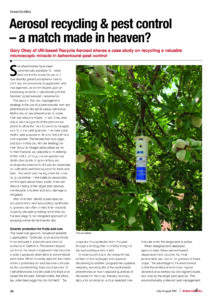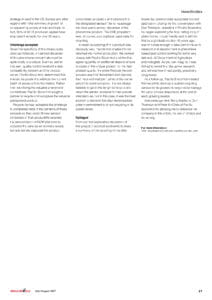Aerosol recycling & pest control – a match made in heaven?
- Gary Okey of US-based Recycle Aerosol shares a case study on recycling a valuable microscopic miracle in behavioral pest control
Sex pheromones have been commercially available for insect pest control for about 35 years. It has steadily gained acceptance due to continual improvements in application and management, as entomologists gain an increasing scientific understanding of this fascinating behavioural phenomenon. The basis of this pest management strategy is the use of a pest species’ own sex pheromone to disrupt its sexual behaviour. Moths rely on sex pheromones to locate their reproductive mates. In fact, it requires only a few nanograms of the pheromone plume to allow the male to correctly navigate and fly to the calling female. The male adult moths’ sole purpose in life is to find a female and copulate. The female then lays eggs, and both moths die. All their feeding (on their favourite foliage) takes place earlier in their lifecycle, as caterpillars. In defense of the moths, although some species are destructive pests, in general they are ecologically essential to the planet, especially as pollinators and food sources for birds and bats. This reinforces the argument for more ‘surgical strikes’ in the battle to responsibly control agricultural insect pests. If we can disrupt mating of the target pest species, the lifecycle is broken and crop damage is mitigated. After chemists identify a pest species’ sex pheromone and successfully synthesise it, growers can often protect their valuable crops by disrupting mating rather than by the less elegant, non-targeted approach of spraying conventional insecticides.
Smarter protection for fruits and nuts
The navel orangeworm, Amyeloistransitella (Lepidoptera: Pyralidae), is an economically important pest in pistachio and almond orchards in California. Pheromone-based control of the naval orangeworm has become a widely accepted alternative to conventional pesticides. When correctly applied, the males within a protected orchard become confused by the overwhelming ‘false scent plumes’ of their pheromone and are unable to track and locate the females. Female moths, therefore, lay unfertilized eggs that do not hatch. The crops are thus protected from this pest through a strategy that is entirely benign to the surrounding environment.
In most recent years, the research has shifted control strategies from passive dispensing to smarter, programmed systems releasing aerosol puffs of the synthesized pheromones at much reduced quantities of dispensers in the crop, thereby reducing labour for application, and at selected time intervals when the target pest is active.
When designed and deployed appropriately, these aerosol-based dispensers have become the most economical pest control for growers of these crops. The advantage to the environment is that the emitted pheromones may be detected at extremely low (nanogram) levels, and only by the target pest species. This environmentally preferred pest management strategy is used in the US, Europe and other regions within the commercial growth of an expanding variety of nuts and fruits. In fact, 95% of all US produced apples have employed this tactic for over 20 years.
Challenge accepted
Given the specificity of this miraculously obscure molecule, an aerosol dispenser of this pheromone concentrate must be quite costly to produce. Even so, earlier this year, quality control revealed a seal compatibility concern and the product owner, Pacific Biocontrol, determined that it would be prudent to withhold the current batch of aerosols from the market. Rather than sacrificing the valuable pheromone concentrate, Pacific Biocontrol sought a partner to recycle and recapture the valuable pressurised product.
Recycle Aerosol accepted the challenge to completely reclaim the contents of these aerosols so they could fill new aerosol containers of their product. We received the aerosol batch of NOW pheromone, recycled the cans as we normally would, but additionally captured the product concentrate separately and returned it to the designated aerosol filler to repackage into next year’s aerosol dispenser of the pheromone product. The DME propellant was, of course, also captured separately for recycling. A clean recapturing of this product was obviously very important to enable it to be returned into normal production. We worked closely with Pacific Biocontrol and the filler, agreeing jointly on additional steps to ensure success of this unique project. To maintain product quality, the entire Recycle Aerosol process was first dismantled and cleaned, then received multiple flushes of the carrier solvent to avoid carryover. It is not always feasible to go to this length to recycle and return the aerosol products to their precise intended use, but in this case, it was the best economic decision that also demonstrated a team commitment to direct recycling in its purest sense.
Epilogue
From our first exploratory discussion of this project, it seemed worthwhile to share a summary of the recycling of this littleknown but commercially successful aerosol application. During my first conversation with Don Thomson, president of Pacific Biocontrol, he began explaining the fascinating story of pheromones. I could hardly wait to tell him that as a graduate student 40 years ago, I was fortunate enough to take part in the early research and development in pheromonebased pest control working for some very talented US Department of Agriculture entomologists. As you can imagine, I was thrilled to revisit this ‘disruptive’ research and witness how it had quietly, practically progressed.
As a follow-up, Pacific Biocontrol insisted that we jointly develop a custom recycling service for its growers to responsibly manage the used aerosol dispensers at the end of each growing season.
Acknowledgement: Many thanks to Don Thomson and Peter McGhee of Pacific Biocontrol for allowing me to reference his company in this article, for use of photos and for editing.

